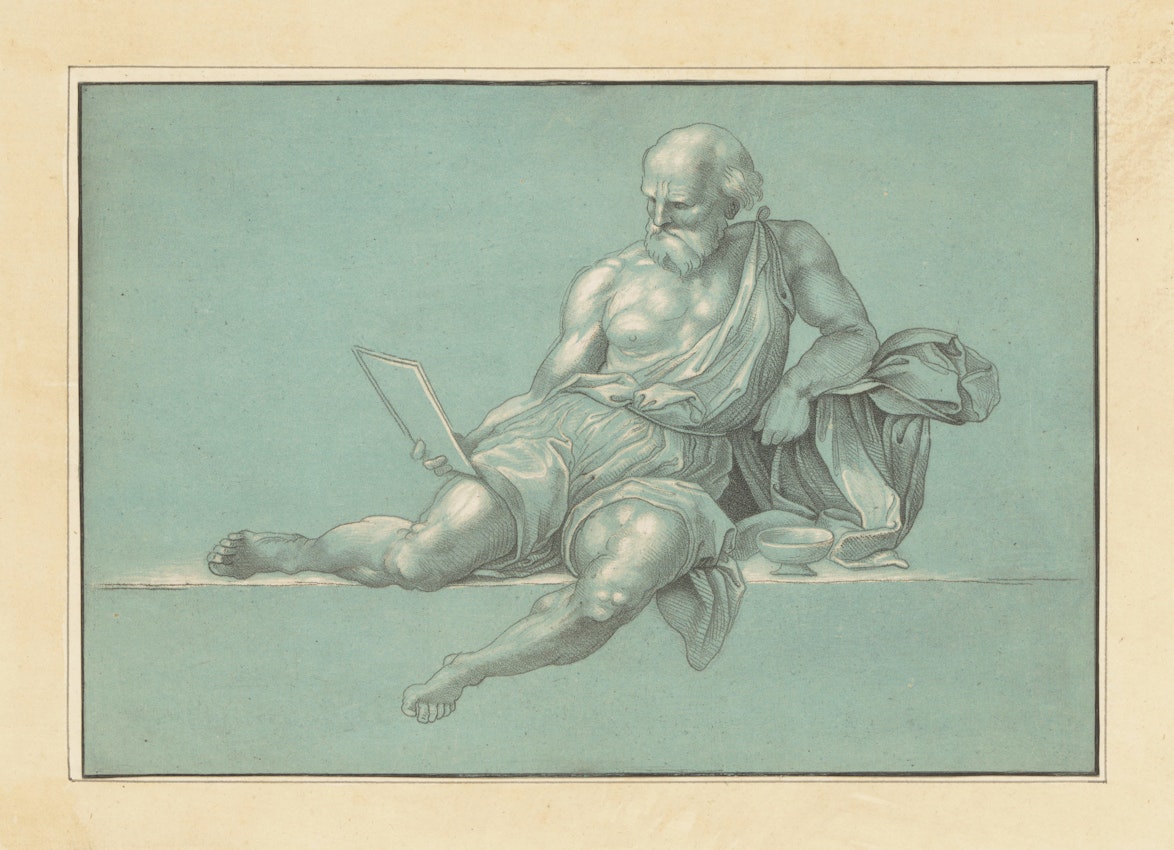
Maria Catharina Prestel’s Printed Cabinet of Drawings (ca. 1780s)
From the Renaissance onward, drawings have fascinated collectors and connoisseurs, who often perceive them as intimate affordances of an artist’s creative process — prized as mediums of an artist’s physical gestures. As unique works, drawings can exist in only one collection at a time, where they are typically secreted away from the vast majority of eager spectators. Reproductions offer art lovers a satisfying degree of access to these works, but to create convincing facsimiles in the early modern era required a challenging technical feat: translating drawings into print.
In the 1770s and 1780s, the enterprising artist Maria Catharina Prestel (1747–1794) was hard at work in Frankfurt, refining her printmaking technique to meet the demand of this secondary drawings market, reproducing sheets by Albrecht Dürer, Raphael, Giulio Romano, and others. She capitalized upon a new printing technique, aquatint, that allowed printmakers to render areas of tone in etchings. In her engaging history of aquatint, Rena M. Hoisington notes that Prestel and her colleagues manipulated aquatint in combination with a host of other intaglio printing processes, including line etching, soft-ground etching, and chalk-manner etching in order to best replicate particular drawings. In some instances, she used several printing plates to create multicolor prints when reproducing drawings with various inks and washes on colored paper. In one particular tour de force, Prestel applied gold dust onto freshly printed ink lines to recreate the metallic tonal heightening of Jacopo Ligozzi’s Triumph of Truth Over Envy.
Together with her husband, Johann Gottlieb Prestel (1739–1808), and an apprentice, Regina Catharina Schönecker (ca. 1762–ca. 1818), Maria Catharina created three portfolios of prints after drawings in private collections, which they took care to reproduce at scale. Although Johann’s name appears on the portfolio covers, it is now acknowledged that Maria Catharina was the creator of a significant portion of the prints, among them some of the most technically complex. She and Johann eventually separated, and Maria Catharina moved to London, where she resumed her printmaking career. She remained there until her death in 1794.
Opening one of the Prestel portfolios was a sensuous and intellectually rewarding experience. The prints were mounted onto sturdy sheets for easy handling, and viewers could bring each one close to their eyes to inspect its numerous details and guess its artist before turning the image over to read the informative inscriptions on the reverse. Hoisington points out that this format allows connoisseurs to admire both the drawings reproduced and the craft of printed facsimiles.
The Prestels’ portfolio titles were in French and are named after cabinets where the drawings they reproduced were kept. Within the world of art collecting, Kabinett (German), kabinet (Dutch), or cabinet (French) refers to a room for viewing collections of small-scale artworks, including drawings. The term encompasses both the physical and metaphorical aspects of enclosure — these were walled spaces designed for the intimate appreciation of treasures. A cabinet is an interior within an interior, a place of privacy and curiosity and mystery, a capsule that contains things to discover. Beyond disseminating drawings of some of the canonical figures in European art, the Prestels offered their collectors just such a room of their own.
Maria Catharina Prestel, Les Chanteurs Rustiques (The Rustic Singers), after Johann Albrecht Dietzsch, ca. 1770–85.
Maria Catharina Prestel, Rütlischwur (Rütli Oath), after Albrecht Dürer, ca. 1757–1794.
Maria Catharina Prestel, Offer aan een vorst (Sacrifice to a Sovereign), after Abraham Bloemaert, 1780.
Maria Catharina Prestel, Landschap (Landscape), after Allaert van Everdingen, 1783.
Maria Catharina Prestel, Dorpsdokter (Village Doctor), after Adriaen van Ostade, 1783.
Maria Catharina Prestel, Jonkvrouw met hond (Gentlewoman with Dog), after Martin Schongauer, 1783.
Maria Catharina Prestel, Oude boer tenmidden van kermisvierders (Old Farmer Amid Fairgoers), after Adriaen Pietersz van de Venne, 1780.
Maria Catharina Prestel, Landschap met stadsmuur (Landscape with City Wall), after Thomas Wijck, 1783.
Maria Catharina Prestel, Zeus op zijn troon (Zeus on His Throne), after Giulio Romano, 1781.
Maria Catharina Prestel, Rivierlandschap (River Landscape), after Jan van Huysum, 1783.
Maria Catharina Prestel, Drie Gratiën (Three Graces), after Bartholomeus Spranger, 1782.
Maria Catharina Prestel, Filosoof (Philosopher), after Rafaël, 1783.
Maria Catharina Prestel, Landschap met vee (Landscape with Cattle), after Georg Wagner, 1783.
Maria Catharina Prestel, Landschap met vee (Landscape with Cattle), after Georg Wagner, 1783.
Maria Catharina Prestel, Bosweg met rustende reizigers (Forest Road with Resting Travelers), after Herman Saftleven, 1783.
Maria Catharina Prestel, Landschap (Landscape), after E. Weirotter, 1783.
Maria Catharina Prestel, Boeren gezelschap met vrouw die man ontluist (Peasant Company with Wife Disrobing Husband), after Isaac van Ostade, 1783.
Maria Catharina Prestel, Allegorie op de Waarheid die de Afgunst overwint (Allegory of Truth Overcoming Envy), after Jacopo Ligozzi, 1781.
Apr 24, 2024









